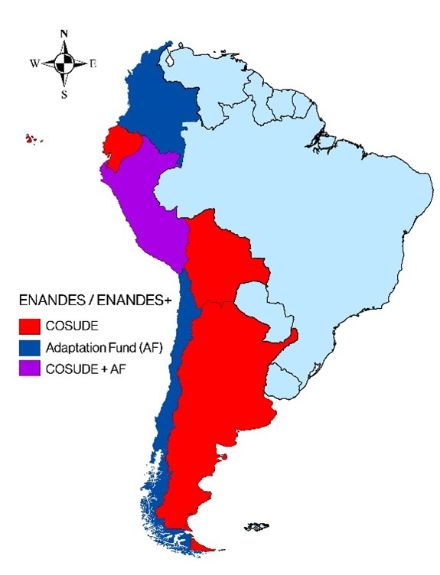Service Navigation
Search
ENANDES+: Improving the Andean region’s adaptation and resilience to a varying and changing climate
ENANDES+ is a contribution financed by the Swiss Agency for Development and Cooperation (SDC) to the WMO project ENANDES. It allows to extend the experience and results gained from the Climandes project, which MeteoSwiss carried out bilaterally with the Peruvian weather service from 2012 to 2018, to almost the entire Andean region: While ENANDES involves Chile, Colombia, and Peru, ENANDES+ also includes Argentina, Bolivia, and Ecuador. ENANDES+ aims to help strengthen the national weather services in the Andean region so that they can better cope with the challenges of climate variability and change.
In addition to the weather services of the various countries, all WMO institutions in the region are also part of the project, namely the regional climate centers for South and West of South America and the regional training centers in Peru and Argentina. Overall coordination is carried out by the World Meteorological Organization (WMO), while MeteoSwiss, together with the School of Agricultural, Forest and Food Sciences (HAFL), is playing an advisory role on key issues in the value chain of weather, water and climate services (WWC services), particularly in the areas of data management, climate analysis, capacity building and the socioeconomic assessment of improved WWC services.
Project objectives
ENANDES+ has three main objectives:
- To improve adaptation to a variable and changing climate
- To strengthen resilience to climate hazards (e.g., drought and frost)
- To enhance coordination and cooperation within the region to make the best use of existing strengths
The project includes various case studies that will serve as a basis for later national implementation. The following examples illustrate the regional and participatory approach that is being applied in different contexts and with different partners:
In Argentina and Bolivia, an early warning system for flash flood alerts and drought monitoring is being developed in the border area of the Pilcomayo River basin, enabling a unique transnational approach to improving climate resilience in the region.
In Ecuador, the National Institute of Meteorology and Hydrology (INAMHI) is working in the upper Pastaza River basin to produce frost warnings for small family farms and hydrometeorological forecasts to support the management of hydropower plants.
In addition, the participating countries are working closely with selected stakeholders and sectors to understand their needs and determine how they would like to receive the services. This co-design process takes place at two levels: on the one hand, MeteoSwiss works with the weather services of the region, and on the other hand, these weather services work with local stakeholders and users. This makes it possible to better assess the socio-economic benefits of the improved WWC services.

NUREX – an innovative regional approach
The South-South cooperation approach plays a central role in achieving the ENANDES+ project goals: While MeteoSwiss worked bilaterally with its partner weather service during the Climandes project, ENANDES+ aims to share knowledge and experience between the Andean countries on a regional level. The focus is on targeted training that imparts the specific knowledge and skills needed to achieve the project goals. This exchange between weather services, regional climate and training centers, and other partner institutions requires a great deal of technical coordination. This is to be ensured by the so-called NUREX (Spanish: Núcleo Regional de Experticia), which acts as a virtual “hub” for regional and Swiss expertise, coordinating and promoting the exchange of knowledge between all project participants.